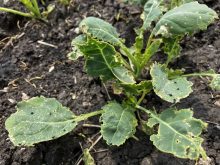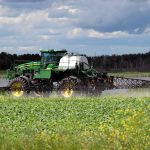SOUTHWEST
Another week of wet weather limited any progress in seeding. The region received about 30 to 120 mm of rain with Wednesday reporting the largest rain event. All runways and ditches were running and many roads were once again closed in several municipalities.
In areas south of Highway 1 overall seeding progress remains at 25 per cent complete. Seeding progress ranges from five per cent complete around Souris, Alexander and Griswold to 55 per cent around Brandon and Rivers.
In areas north of Highway 1 seeding is 55 per cent complete overall, ranging from 40 per cent complete around Hamiota and Oak River to 75 per cent around Russell.
Read Also

CUSMA access key among other trade noise: Seeds Canada panel
Seeds Canada conference panelists say Canada needs to stay focused and wait as U.S. trade and tariff chaos develops, and a Canada-U.S.-Mexico Agreement review looms
Early-seeded cereals are in the three-to five-leaf stage and need to be sprayed as weeds are growing quickly. Canola development ranges from emergence to the three-to four-leaf stage. Canola seeded by plane seems to be emerging well and the next issue for these crops is fertilizing and weed control. Significant pressure on canola from flea beetles was reported over the past week.
Winter wheat and fall rye are doing well with some fields starting to head. Application of fungicide will be needed shortly. Hay crops on those acres able to be harvested have progressed well and an average yield is forecast.
NORTHWEST
From early Monday morning through to mid-week, The Pas and Roblin saw up to 25 mm of rain, with Swan River receiving 50 mm. About 40 to 50 mm of rain also affected the wet areas east of the Riding and Duck Mountains to Lake Manitoba. Unsettled weather and light scattered showers continued through most of the region through the week.
Overall seeding progress is 50 per cent complete in eastern areas. No field and seeding operations were done this week. Seeded estimates range from lows of 35 to 50 per cent complete around the Gilbert Plains, Ethelbert, Fork River, Ste. Rose and Dauphin areas to 75 per cent complete around Grandview. Many fields had been sprayed and prepared for seeding when the rain arrived. Reports indicate that in some areas, significant acres of canola have been broadcast- seeded and harrowed.
Crop staging in those areas is variable with about 75 per cent of the crop not yet emerged. Slow, uneven germination and soil crusting continue to be of concern. Localized heavy downpours have also caused some erosion of fields and crop loss.
Flea beetle activity has increased but diamondback moths trap counts remain very low across the region. Spring crop diseases have not been reported to date. Fungicide treatments in winter wheat have begun.
Generally, in areas where soil and moisture conditions are more favourable, hay and pasture fields continue to improve from the recent heat and are in good condition.
CENTRAL
Rain showers were variable with a few areas seeing very little accumulation; however, much of the region saw 25 up to 65 mm. Areas closer to Lake Manitoba received 75 to 100 mm of precipitation.
Warmer temperatures encouraged both crop and weed growth; some fields are yellowed due to excess moisture. Seeding is wrapping up with the arrival of crop insurance deadlines.
Seeding progress ranges from 25-35 per cent complete at Gladstone to 100 per cent at Carberry. A significant number of acres will remain unseeded. Corn, soybean, edible beans, flax, pea and sunflower acres are lower than first intended. Some fields have been reseeded to the same crop while majority of others have changed to canola.
Crop staging varies widely with late-seeded crops just germinating. Some later-seeded areas will have challenges with spray timing and, later in the season, harvest timing.
Herbicide applications continue, with timely spraying a struggle in many cases. Some crops are developing past the stage for timely herbicide applications. The wet weather is also resulting in weed concerns; weeds that flourish in wet conditions, such as dandelions, thistles, curled dock, quackgrass and barnyard grass, are common.
Some fungicide applications have been made to winter wheat with more to come in the next week to 10 days. Leaf spot diseases are evident in spring wheat.
Flea beetles are chewing on canola and may be more of a problem with spotty emergence and slow growth. Perimeter spraying of fields is occurring, particularly in western areas of the region. Diamondback moth counts are generally low, as are bertha armyworm moth counts.
EAST
Rainfall amounts over the region varied significantly with most areas seeing relatively low amounts ranging from two to 12 mm. Producers tried to get in any final acres. Also, spraying was very general for both herbicides and fungicides. Weed pressure is quite high and producers had to rush to be timely with herbicides.
There are areas north, east and southwest of Beausejour that saw repeated accumulations of 25 mm or more over the past two weeks that have kept producers out of the fields. Acres in these areas are only 50 to 75 per cent seeded.
Across most of the region, emergence of wheat ranged from 40 to 100 per cent. A similar situation exists for barley and oats where emergence ranges from 25 to 100 per cent and 60 to 95 per cent, respectively. Canola ranged from 50 to 100 per cent emerged. Flea beetle damage has been observed and some insecticide application has occurred. Early-seeded but very unevenly emerged crops were particularly vulnerable. Flax ranged from 20 to 100 per cent emerged and soybeans, 70 to 100 per cent emerged. Corn is 100 per cent emerged; sunflowers, mostly emerged.
Many plants are stressed from excess moisture and are growing slowly. Crops appear to be more advanced in the southern areas of the region.
Winter wheat conditions are rated as good across the region. Fungicide applications for fusarium head blight may begin by the end of this week. In areas of the region with greater cumulative rainfall amounts, field scouting is revealing the occurrence of downy mildew and tan spot.
Hay conditions continue to be rated as good across the region.
INTERLAKE
Heavy rain fell over most of the region Monday evening. Amounts ranging from 25 to 150 mm were reported in the south Interlake, and from zero to 50 mm further north.
Seeding progress in the south Interlake is estimated to be 85 per cent complete and the north, 45 per cent complete. The Arborg/Riverton areas are over 70 per cent complete while the Fisher Branch area is less than 20 per cent complete with no further progress expected. Reseeding of drowned-out crops, or crops impacted by seed rot, is occurring in many areas. Seeding of greenfeed crops is expected after the June 20 deadline.
Herbicide applications were general over the weekend in areas dry enough to support field equipment. Fungicides are being applied to winter wheat crops.
Haying has begun across the region with most fields harvested as round bale silage. Yields are below normal but quality is generally above normal. Older stands are in need of rejuvenation as excess moisture has restricted removal of these stands. New stands are producing very good yields. Pastures are being impacted across much of the region due to wet conditions.


















